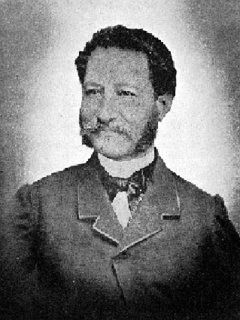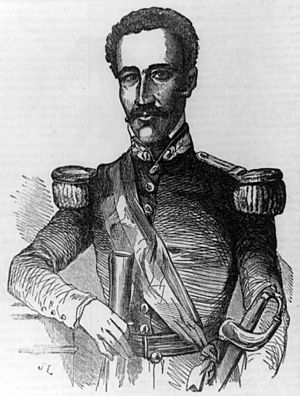Buenaventura Báez facts for kids
Quick facts for kids
Buenaventura Báez
|
|
|---|---|
 |
|
| President of the Dominican Republic | |
| In office May 29, 1849 – February 15, 1853 |
|
| Preceded by | Manuel Jiménes |
| Succeeded by | Pedro Santana |
| In office October 8, 1856 – June 13, 1858 |
|
| Vice President | Domingo Daniel Pichardo Pró |
| Preceded by | Manuel de Regla Mota |
| Succeeded by | José Desiderio Valverde |
| In office December 8, 1865 – May 29, 1866 |
|
| Vice President | Francisco Antonio Gómez y Báez |
| Preceded by | Pedro Guillermo |
| Succeeded by | Triumvirate of 1866 |
| In office May 2, 1868 – January 2, 1874 |
|
| Vice President | Manuel Altagracia Cáceres (1868-1871) Juan Isidro Ortea y Kennedy (1871-1874) |
| Preceded by | Manuel Altagracia Cáceres |
| Succeeded by | Ignacio María González |
| In office December 26, 1876 – March 2, 1878 |
|
| Vice President | Vacant |
| Preceded by | Marcos Antonio Cabral |
| Succeeded by | Ignacio María González |
| 4th Vice President of the Dominican Republic | |
| In office 6 October 1856 – 8 October 1856 |
|
| Preceded by | Antonio Abad Alfau Bustamante |
| Succeeded by | Domingo Daniel Pichardo Pró |
| Personal details | |
| Born |
Ramón Buenaventura Báez Méndez
July 14, 1812 Barahona, Captaincy General of Santo Domingo |
| Died | March 14, 1884 (aged 71) Hormigueros, Puerto Rico |
| Nationality | Dominican |
| Political party | Red Party |
| Relations | Marcos Antonio Cabral (son-in-law) Virgins of Galindo (nieces-in-law) Antonio Sánchez-Valverde (grandfather) Ana Valverde (second cousin-once removed) José Desiderio Valverde (third cousin) |
| Children | 9 (possibly more) |
| Parents |
|
Ramón Buenaventura Báez Méndez (July 14, 1812 – March 14, 1884) was an important politician and military leader in the Dominican Republic. He served as president of the Dominican Republic five different times. His time in power was often seen as unfair, as he focused on increasing his own wealth.
Buenaventura Báez is considered one of the founders of the modern Dominican upper class. Many of his family members still play a big role in the politics and economy of the Dominican Republic today.
He had several children, and he officially recognized nine of them. Some were born in the Dominican Republic, while others were born in Puerto Rico and France.
Early Life and Family
Báez was born in a place called Rincón (now Cabral) in what was then the Captaincy General of Santo Domingo. He grew up in his father's hometown of Azua. His parents were Pablo Altagracia Báez and Teresa de Jesús Méndez.
His father, Pablo, was a very rich merchant from Azua. He was raised by a French silversmith and became a successful businessman. Pablo owned many slaves. Teresa de Jesús Méndez was a mixed-race woman who had been a slave from Rincón. Pablo bought her and later freed her. Pablo and Teresa had seven children together.
Báez had light hair and blue eyes like his father, but also curly hair and a slightly darker skin tone. This earned him the nickname Jabao. He was well-educated and good-looking, which made him popular. Because his family was wealthy, he was able to study in Europe, especially in France. There, he learned several languages, including English and French. When his father passed away in 1841, Báez was 29 years old. He inherited a large fortune, which he used to start his political career. In 1843, he was elected as a representative to the Haitian Constituent Assembly.
Political Career
From 1843, Báez worked as a representative for Azua in the Haitian government. He got this job partly because he helped in the revolution that removed President Jean-Pierre Boyer from power. As a representative, Báez tried to change the Haitian Constitution to be fairer to white people, but he was not successful.
At first, Báez was completely against the idea of the Dominican Republic separating from Haiti. However, on December 15, 1843, Báez suggested to the French consul, Auguste Levasseur, that France should take over the Spanish-speaking part of the island as a protectorate. This meant France would protect and partly control the area. In return, Báez wanted guns and warships to help fight for independence from Haiti. The French consul was interested and kept in touch with Báez and his group.
When the independence revolution began, Báez was against the Trinitarians, who were fighting for freedom. He even put some of them in prison. He tried to stop the Act of Independence from being published in Azua in January 1844. In February, he did not allow the new Dominican flag to be raised in the city square. He felt that a rebellion against Haiti without foreign help would fail because the Haitians had more people. But when he saw how much the people wanted independence, he changed his mind. He decided it was time to break away from Haiti.
In 1844, Báez helped lead a successful rebellion against Haiti. This led to the independence of the Dominican Republic. In 1846, he traveled to Europe to try and convince France to make the Dominican Republic a protectorate, but France said no. He became president for the first time in 1849 and served until 1853. During this time, he tried to convince the United States to take over the country. He was president again from 1856 to 1857, but he was removed from power in a coup.
Next, Báez supported the idea of Spain taking over the Dominican Republic. He went to live in Spain and enjoyed a very luxurious life there. Spain agreed to occupy the Dominican Republic in 1861. However, by 1865, they left the country (this was called the Dominican Restoration War). Báez then returned to the Dominican Republic and became president again. He was removed from power in another coup in May 1866.
He then served his longest term as president, from 1868 to 1874. During this time, he tried once more to get the United States to annex (take over) the Dominican Republic. He almost succeeded, as he convinced American President Ulysses S. Grant to send warships to the Dominican Republic. A treaty for annexation was even written and presented to the United States Senate. However, the treaty was not approved by the U.S. Senate.
In 1869, Báez arranged a loan with Edward Hartmont, a British financier. The loan was very expensive for the country. Hartmont promised a large sum of money, but with very strict conditions. The Dominican government had to pay a huge fee from their customs money. Also, the country's coal mines and forests were used as collateral for the loan. Báez only received a small part of the promised money. Some of this money ended up in his own pockets and those of his supporters. The rest was used to fight against his political enemies.
Exile and Death
Báez became President one last time from 1876 to 1878. He was then removed from power in a final coup. He was sent to live in Puerto Rico, which was a Spanish colony at the time. He spent his last days there. He is buried in the Basilica Cathedral of Santa María la Menor.
Offspring
Studies of family history show that President Báez, along with President Espaillat, are ancestors to many of the most powerful families in the Dominican Republic. Their children and grandchildren formed connections with the richest and most influential families from Santiago and across the country.
See also
 In Spanish: Buenaventura Báez para niños
In Spanish: Buenaventura Báez para niños


